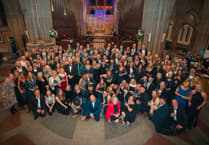EXCAVATIONS at St Sampson’s Church in South Hill, near Callington, have revealed a remarkable glimpse into the town’s past.
Floor excavations in preparation for restoration work in the Manaton Chapel have uncovered ancient burials, believed to be members of the Manaton family, who were prominent in the area from around 500 years ago.
A service of blessing for the burials took place on the evening of Sunday, September 28 – and archeologists have been on site this week investigating the finds. The public will have the opportunity to view the discoveries on Friday (October 3) from 12pm to 6pm, providing a rare chance to see unique aspects of local history up close.
The Manaton family is believed to have arrived in South Hill from Manaton on Dartmoor in Devon, the origin of their surname. The earliest recorded family member in the vicinity of St Sampson’s is Richard de Manaton, dating back to 1185. Richard and his descendants acquired lands near the church, now known as Lower Manaton and Higher Manaton, with the stone gate at the entrance to the manor still visible from South Hill Road.
By the 15th century, the north transept of St Sampson’s Church was being used by the Manatons as a private chapel, now known as the Manaton Chapel. Family members worshipped there, leaving floor and wall monuments, and interring their dead in burial vaults beneath the floor.
Burials may have begun around 1500, though the first documentary evidence dates to 1663, with the wall monument to Michael Hill (1655–1663) commemorating his burial in the chapel. The inscription on the monument reads: “Near unto this place Lieth the Body of Michael Hill…who dep’ted this life the 17th of June, 1663,” and includes the verse: “Stranger that so high a Hill sinks so low A Vault to fill.”
Wills left by the Manatons provide further insight into the burials. Elizabeth Manaton (c. 1625–1716/7) requested in her 1709 will that her body be “committed to Christian Buryall in the Parish Church of Southill.” Her executor, her son Francis Manaton (c. 1663–1735), also requested burial in the family aisle, describing it as “amongst my ancestors.” Francis, an attorney and tax collector for the land tax, ordered the reconstruction of the stone gate at Manaton Manor during his lifetime.
Sampson Manaton (1692/3–1737), Francis’s eldest surviving son, similarly requested burial in the Manaton Chapel. He died without heirs, leaving his estate to his cousins in Tavistock, who were later buried there. Sampson may have been the last Manaton interred in the family vault.
Osteological investigations are ongoing with the consent of a living relative, and the work promises to shed more light on this historic family and their connection to South Hill. Archaeologists and church volunteers alike describe the experience as fascinating, offering a tangible link to centuries of local history.
Visitors to the public viewing will have the chance to witness these discoveries for themselves and gain insight into the lives and legacy of the Manaton family in Cornwall.





Comments
This article has no comments yet. Be the first to leave a comment.